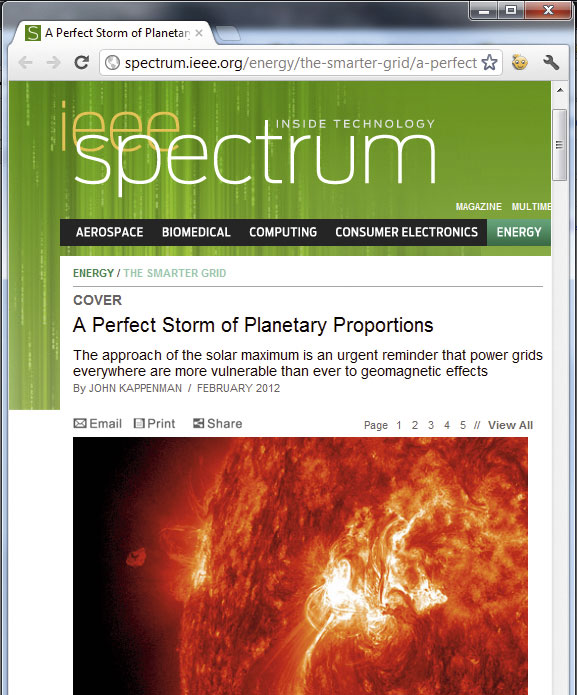“Power grids everywhere are more vulnerable than ever for geomagnetic effects,” says John Kappenman in IEEE Spectrum, about the upcoming maximum in solar storms.
“Solar activity tends to occur in cycles that peak in frequency and intensity every 11 years, and the next peak is expected later this year or early the next,” says John Kappenman. “To be sure, not every peak — also known as a solar maximum — brings a killer storm; the last notable one occurred in March 1989. It took down Quebec’s entire grid within seconds, leaving 6 million customers without power for 9 hours. A later surge in the storm destroyed a large transformer at a New Jersey nuclear plant and nearly took down US power grids from the mid-Atlantic through the Pacific Northwest. But that geomagnetic storm was not so bad, it turns out.”
Kappenman, a leading US expert in geomagnetic storms, knows how to sell his story. But TU expert on electrical power systems, Professor Lou van der Sluis, is a bit sceptical about the article. He agrees that solar storms present a real challenge for the power grid, but he disagrees with both Kappenman’s physics and his proposed solution. “For every difficult problem there is always a simple answer and most of them are wrong,” he cites from a book of Clayton R. Paul.
Physics first. As a good teacher, Van der Sluis starts at the beginning: the enormous currents of charged particles that swirl over the sun’s surface. Occasionally, a cloud of electrons and protons is ejected and may intersect the Earth’s orbit. Deflected by the Earth’s magnetic field, the current of charged particles will cause a change in the magnetic field. This will cause a potential difference in closed contours formed by suspended high voltage cables and conduction through the ground. If the contour is electrically conducting, an induction current will start to flow.
“The trouble with the induced current is that it gives rise to non-linear effects in transformers,” says Van der Sluis. This will result in heat production in the transformers. The professor estimates that a transformer can overheat in several minutes. Reducing the load can prevent further damage. “It doesn’t necessarily lead to a cascade of collapsing transformers, as Kappenman suggests.”
As a remedy, Kappenman proposes to fit capacitors into the ground leads of the high voltages transformers, in order to prevent DC currents from creeping into the power system (only AC currents can pass through capacitors). Van der Sluis doesn’t agree. First, because he doesn’t believe in creeping currents – instead he argues the currents are caused by induction in a closed contour. And secondly, because past experiences have proved fixed grounding of HV transformers a safe and sound practice, which Van der Sluis would not want to see sacrificed. “A capacitor in the ground lead will lead to floating HV potentials,” he says. “You don’t want that to happen.”
Van der Sluis thinks that the Dutch grid is much less vulnerable to geomagnetic storms than the US power grid, because the contours through which induction occurs are much smaller: transmission towers are lower here, because the transmission voltage is also lower (380 kV); the lines are generally shorter and the groundwater near to the surface is a good conductor (as opposed the more rocky US soil). Moreover, he argues that preventive measures are unnecessary as long as grid operators keep a watchful eye over their transformers when a solar storm is underway.
Clayton R. Paul: ‘Introduction to Electromagnetic Compatibility’
Een bekend Chinees spreekwoord luidt: er zijn drie soorten leugens: grote leugens, kleine leugens en statistieken. Of is het toch wel handig om je kilometerkosten tijdens de huisvakantie goed bij te houden? En snel een goedkoop tankstation vinden zal je portemonnee ook goed bevallen.
Met FuelNode kun je snel het goedkoopste tankstation in de omgeving vinden. Als je de app start, krijg je een kaart van de omgeving te zien. Hierop verschijnen groene, gele en rode labels met daarin de literprijs. In principe zijn alleen de groene interessant, daar kunnen we namelijk het goedkoopst terecht.
Druk op een label en alle gegevens van het tankstation staan voor je neus. Nog een beweging verder en de navigatie staat al klaar om je naar de goedkope oliebron te leiden.
Dat de brandstofprijzen stijgen, zal iedereen weten. Om de kosten binnen de perken te houden, is het verstandig om ze goed bij te houden. Door bij elke tankbeurt even je bonnetje in te voeren in aCar krijg je snel overzicht van verbruik en kilometerkosten. Daarnaast kun je ook onderhoudskosten bijhouden. Recent is de mogelijkheid om tripkosten bij te houden toegevoegd, ideaal voor een huisvakantie. Tegen een kleine betaling kun je mooie grafiekjes en dagelijkse back-ups unlocken.
De kilometers en euro’s vliegen er uit als je er niet op let. Bewust zijn van de gemaakte kosten is bijna de helft van het besparen.



Comments are closed.